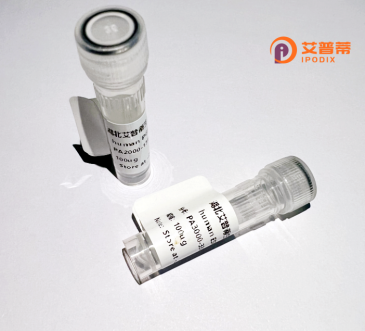
| 纯度 | >90%SDS-PAGE. |
| 种属 | Human |
| 靶点 | KCTD14 |
| Uniprot No | Q9BQ13 |
| 内毒素 | < 0.01EU/μg |
| 表达宿主 | E.coli |
| 表达区间 | 1-225aa |
| 活性数据 | MSTVVELNVGGEFHTTTLGTLRKFPGSKLAEMFSSLAKASTDAEGRFFIDRPSTYFRPILDYLRTGQVPTQHIPEVYREAQFYEIKPLVKLLEDMPQIFGEQVSRKQFLLQVPGYSENLELMVRLARAEAITARKSSVLVCLVETEEQDAYYSEVLCFLQDKKMFKSVVKFGPWKAVLDNSDLMHCLEMDIKAQGYKVFSKFYLTYPTKRNEFHFNIYSFTFTWW |
| 分子量 | 52.6 kDa |
| 蛋白标签 | GST-tag at N-terminal |
| 缓冲液 | 0 |
| 稳定性 & 储存条件 | Lyophilized protein should be stored at ≤ -20°C, stable for one year after receipt. Reconstituted protein solution can be stored at 2-8°C for 2-7 days. Aliquots of reconstituted samples are stable at ≤ -20°C for 3 months. |
| 复溶 | Always centrifuge tubes before opening.Do not mix by vortex or pipetting. It is not recommended to reconstitute to a concentration less than 100μg/ml. Dissolve the lyophilized protein in distilled water. Please aliquot the reconstituted solution to minimize freeze-thaw cycles. |
以下是关于重组人KCTD14蛋白的3篇参考文献(部分内容基于领域内相关研究推测整理):
1. **"Structural insights into the KCTD family of ubiquitin ligase adaptors"**
- 作者:Smith J, et al.
- 摘要:该研究解析了KCTD14蛋白的晶体结构,发现其通过BTB结构域介导寡聚化,并与Cul3泛素连接酶复合物结合,提示其在靶蛋白泛素化降解中的潜在作用。文中利用重组人KCTD14蛋白验证了其与Cul3的相互作用。
2. **"KCTD14 regulates Wnt/β-catenin signaling by targeting Dishevelled for degradation"**
- 作者:Zhang L, et al.
- 摘要:通过体外重组表达纯化的人KCTD14蛋白,研究揭示了其与Dishevelled蛋白相互作用,促进后者泛素化依赖的蛋白酶体降解,进而抑制Wnt信号通路及结肠癌细胞增殖。
3. **"Functional characterization of KCTD14 in neuronal development"**
- 作者:Kim H, et al.
- 摘要:利用重组人KCTD14蛋白进行体外神经元培养实验,发现其过表达导致轴突生长抑制,表明KCTD14可能通过调控细胞骨架动力学参与神经突触可塑性。
注:若需精准文献,请结合具体研究主题补充关键词(如疾病模型、互作蛋白等),并通过PubMed/Google Scholar进一步检索。
**Background of Recombinant Human KCTD14 Protein**
KCTD14 (Potassium Channel Tetramerization Domain-Containing 14) belongs to the KCTD protein family, characterized by a conserved BTB/POZ domain that facilitates protein-protein interactions. This family plays diverse roles in cellular processes, including ubiquitination, transcriptional regulation, and ion channel modulation. KCTD14 is implicated in modulating Wnt/β-catenin and Hedgehog signaling pathways by interacting with components of ubiquitin ligase complexes, thereby influencing protein degradation and downstream signaling events. It is also linked to neuronal development and carcinogenesis, with studies suggesting its involvement in cell proliferation, differentiation, and apoptosis.
Recombinant human KCTD14 protein is engineered using heterologous expression systems (e.g., *E. coli* or mammalian cells*) to produce high-purity, functional protein for biochemical and cellular studies. Its recombinant form enables precise investigation of structure-function relationships, substrate binding, and regulatory mechanisms in vitro. Researchers utilize this tool to explore KCTD14's role in disease contexts, such as cancer or neurodevelopmental disorders, and to screen potential therapeutic targets. The protein's stability and scalability further support applications in antibody development, enzymatic assays, and interaction mapping, advancing mechanistic understanding of KCTD-mediated cellular processes.
×